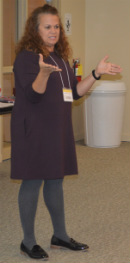A new banner meant to create a shared experience across age groups is getting educators, administrators and parents out of their seats, partnering up and modeling what their K-8 classrooms will come to look like.
They’re learning the ropes of Responsive Classroom, a teaching model focused on the link between academics and social-emotional learning.
In a recent workshop with Cedar Springs staff, consultant Carolyn Rottman opened the day with energizers – fun exercises to get students engaged – and modeled language appropriate for given age groups. Then, staff numbered off and left their seats.
Later, workbooks open on their laps, Cedar Trails teachers Jill Matthews and Michelle Conley discussed using “logical consequences.” Ripping paper by hand, they agreed, is a better consequence for misusing scissors than taking away recess time.
Cedar Beach Principal Miranda Latimer and Cedar View teacher Sadie Gallagher said they never realized how energizers can help both with students who behave and those who don’t.
“Energizers create a positive feel,” Latimer said. “They don’t take very long, but students come out with focus.”

Transforming School Culture
Starting with Cedar Trails last year, the district brought on Cedar Beach for a pair of two-day trainings that began in October and will wrap up later this year. Rottman will then observe teachers in their classrooms as they gradually adopt new ways of managing a classroom aimed at boosting student cooperation, energy, attention and self-control.
Teachers will start simple — with a morning meeting or a modeling how students should retrieve backpacks at the end of the day — and slowly add new ways of organizing their classrooms and incorporating time for “brain breaks” or songs for younger students.
In over 20 years of consulting on Responsive Classroom, Rottman said the structure allows for creativity while providing purpose and a set of expectations for students.
“To me, it’s a way of being with kids,” she said. “It’s a core belief system. The structures provide a constant daily focus rather than just something you do once in one lesson you teach and it’s gone.”

Cedar Springs has a campus structure, with its buildings designated as pre-K, K-first, second-third and so on. With constant transitions, Superintendent Laura VanDuyn explained, the Responsive Classroom structure can help bring consistency that can make new buildings feel familiar.
From walking silently down the hallway to grabbing backpacks at the end of the day, having a set of expectations makes things easier on teachers and provides expectations that boost student achievement, she said. The implementation of new practices takes time, she added, but in the coming years the practice will begin to take root.
VanDuyn learned Responsive Classroom from Rottman while principal at a diverse, high-poverty district in Minneapolis. After seeing its transformation of school culture there, she said, she has since helped other districts adopt the program.
“It’s about a sense of community,” she said. “It’s about caring for one another. It’s about having a very safe environment in which to learn, and that all feeds into the academics.”
CONNECT









